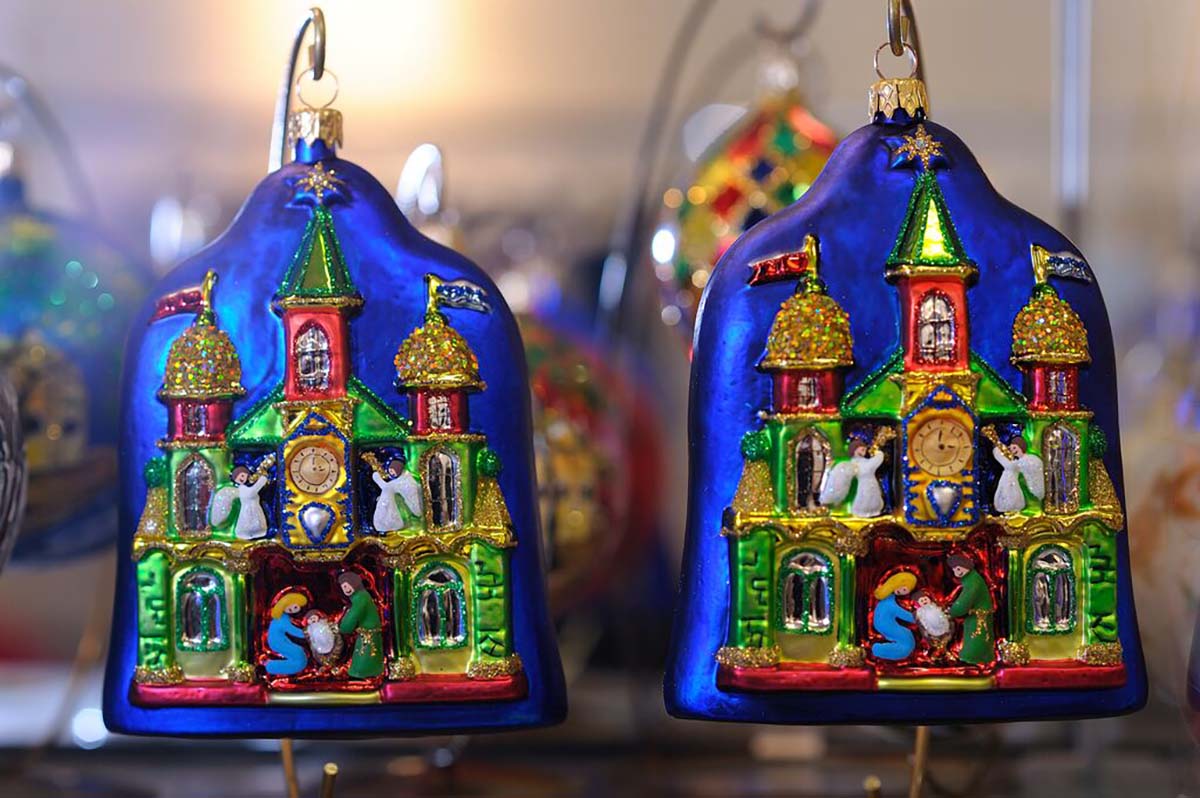When travelling to a new city, most of us love picking up a keepsake singluar to that place. If you’re looking to head home with a piece of Krakow in your pocket, we’ve put together a list of galleries and stores where you can buy unique and locally name souvenirs. (Looking for more? Check out our Made in Krakow shopping tour.)
Mila for unique pottery
Mila is where to go for great pottery, crystal and unique products made in Poland. Look especially for the ceramic sets from the city of Boleslawiec. With its white and navy blue colours and circle of flower patterns, it’s very easy to recognise. And don’t be afraid your items will break while travelling, as the staff pack everything perfectly for staying safe. The shop also offers the option to send your items via post. Alternatively, choose just a small and cheaper piece of this special ceramic, such as a magnet, thimble or cup holder. 14 Slawkowska Street, Krakow
Szambelan for homemade liquor
Szambelan is a unique shop with high-quality liquors, produced locally according to traditional recipes. You’ll be surprised by the beautiful, huge glass containers located along the wall and the number of different flavours available to try (or buy as a great gift from Krakow!). Our favourites include cherry and orange-chocolate liquors, but if you want something stronger, don’t hesitate to sample the Wormwood, a plum liquor, at 70% alcohol. You can also order a cup of coffee there, but who is drinking coffee when you’re surrounded by high-quality liquors, made according to a traditional formula? 9 Bracka Street, Krakow

When in Krakow, visit Syncret for handmade jewelry | Photo by Krakow Urban Tours
Syncret for handmade jewelry
Syncret is a jewelry shop located in the same building as where the old renaissance Goldsmiths’ Guild of Krakow used to be. So as you can imagine, it is a very special, historic place. The tradition is continued by Syncret’s master goldsmiths. The magically decorated store displays the most beautiful pieces of handcrafted gold, platinum and silver jewelry in many styles, from Art Deco to classic and minimalist. Carefully selected and handcrafted gemstones by goldsmiths make Syncret a unique place to fulfill any jewelry dreams. Inside the shop there’s a possibility you’ll see the precise machines used for diamond-turning and even find out if your jewelry is real — and what it would be worth nowadays. 8 Bracka Street, Krakow
Wawel for Krakow’s best chocolate
Wawel is originally the name of the most famous place in Krakow — a huge hill where the Royal Castle and the Royal Cathedral are located. But Wawel is also a brand name of a traditional confectionery business. Created by the “Chocolate King,” Adam Piasecki, in the 19th century, the brand is still known in Poland today. At Wawel, you’ll find the best selection of chocolates and candies in Krakow (and maybe even in Poland). Behind many of the sweet names are some interesting stories. For example, the Danusia chocolate bar was named by Piasecki in honour of his beautiful employee, Danusia, who he never married because of the differences in their family status. Kasztanki (chestnut) candies were invented during a charity auction to support the rebuilding of Wawel Castle. According to folklore, Piasecki was walking under the chestnut tree and thought how the chestnut has an original and unique taste. And it has indeed! 33 Main Market Square, Krakow
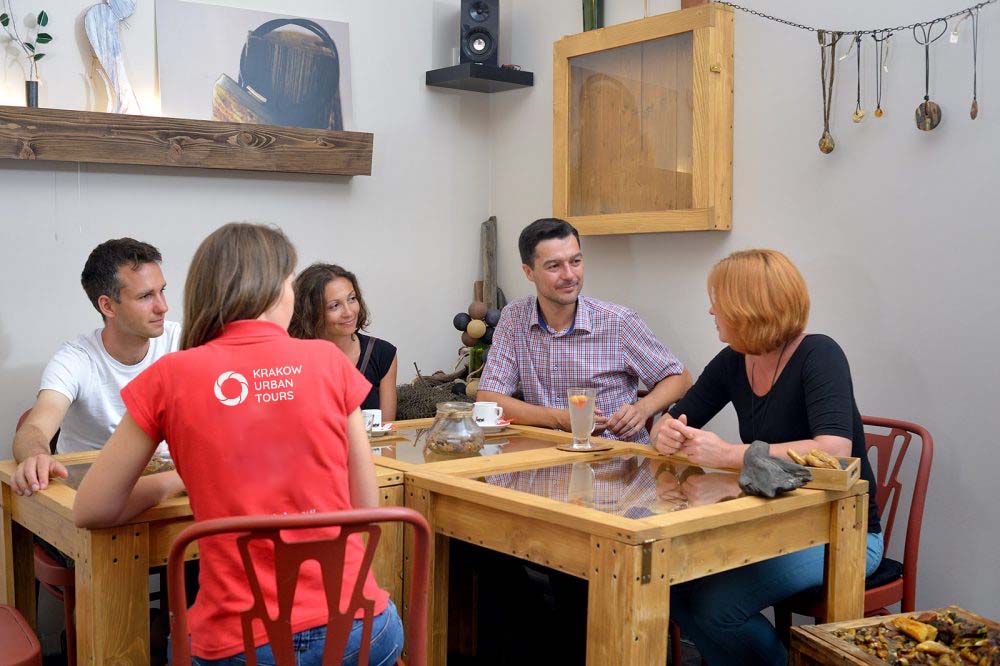
Discover unique amber at Qubic Art | Photo by Krakow Urban Tours
Qubic Art for amber
The first thing you can discover at Qubic Art is that the amber they sell is a fossil resin, not stone. It is much lighter than stone and much heavier than plastic. Gallery owner and talented artist Małgorzata Stawniak can explain why Polish amber is quite hard to work on and, at 54 million years old, is the oldest amber found. In this unique gallery, you can admire beautiful jewelry and distinct pieces of amber in different shapes and colours. Visitors can also find out more about this special material — from old legends and the traditional medical functions of amber, to modern fashion shows and how amber is processed. Izaak Square, Krakow
KOKOworld Gallery for locally designed clothes
KOKOworld was founded on a passion for travelling and fair trade. It’s a place where interest for other cultures and remote corners of the world meet with a faith that small steps can make the world the better place. Inspired by her exotic journeys, gallery founder Agata Kurek decided to dedicate her time and efforts to create something extraordinary — a place where socially responsible fashion meets Polish craftspeople, cooperating and sharing their experiences with artisans around the world. At KOKOworld every piece has its own unique story and international value — it starts somewhere in Africa or Latin America where somebody (known personally to Agata) has an idea and makes a pattern. That design is then sewn in local sewing rooms near Krakow. 19 Starowislna Street, Krakow
Kacper Global for handmade shoes
There are many shoe shops in Krakow, but one of them is really worth visiting. Kacper Global salon is located in Kazimierz district, very close to the Temple Synagogue. It’s not just another shop with leather shoes; Kacper Global has been operating since 1997 and is owned by the same family of shoemakers. All the shoes here are produced by hand in the factory near Krakow. Kacper Global employs three shoe designers who travel to all the important fashion shows around the world. No wonder the store prepares up to 50 new patterns in a variety of colours each year. 33 Miodowa Street, Krakow
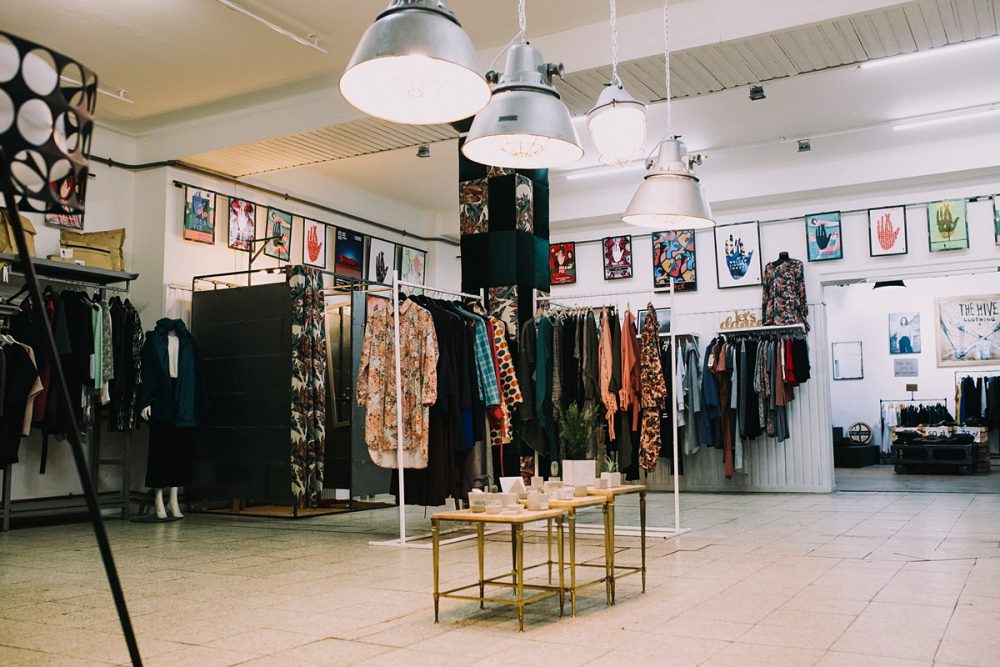
This concept store is stocked with local designers | Photo by Krakow Urban Tours
IDEA FIX for Polish designers
IDEA FIX is more than a concept store. It is a place where Polish fashion, art and design meet, a place where you stumble upon a fashion show or even a creative business conference. IDEA FIX was established in 2009 as the very first concept store promoting only Polish brands and designers. Currently the store is located in the former “Kolejarz” (Railwayman) Theatre, where it hosts nearly 100 clothing, accessories, applied art and jewelry designers, as well as artists. 7 Bochenska Street, Krakow
Jozefa Street for local galleries and souvenirs
Jozefa Street has a unique charm thanks to its murals, small galleries and local restaurants. Here, you can find everything from handmade Polish pottery and elaborated jewelry to wooden toys, old photos or postcards and unexpected trinkets. Visit the garden of Wrega pub in the summer. With its enormous mural depicting the personalities who made the Kazimierz district important, it’s easy to find. Jozefa Street, Krakow
Where to celebrate the Assumption of Mary in EuropeAugust 15 is a big celebration in most European cities. It is a religious event, honouring the Assumption of Mary, and the day is marked with a principal feast of the Blessed Virgin, or the mother of Jesus Christ. The Assumption of Mary is celebrated across Europe, and if you’re visiting in August, here is where you can join in the festivities and celebrations in Poland, Spain, Greece and Romania.
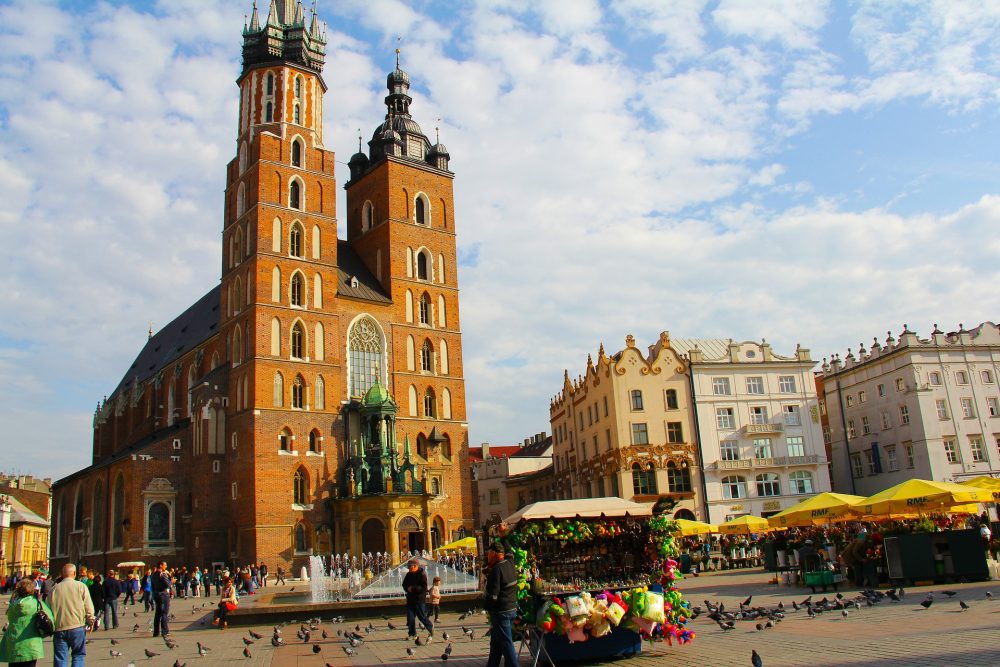
Celebrate the Assumption of Mary in Krakow at a local church | Image credit Pixabay
Poland
Krakow
If you are going to spend your holiday in Poland, don’t miss the August 15 celebrations! This is a unique day where old pagan traditions mix with folk and Catholic traditions — to such an extent that sometimes it’s difficult to recognise where sacrum ends and profanum begins.
The Assumption of the Virgin Mary is also known as The Lady of Flowers holiday. Why this name? There are at least two reasons. Firstly, the religious dogma says that Mary, mother of Jesus, did not die, but fell asleep on Earth and woke up in heaven. Instead of a body, people found fresh flowers and herbs at her grave. The other reason is that mid-August is the time of harvest in Poland. This big, colourful festival to celebrate the end of field work has endured in Polish culture since pagan times. It is a time to dress up, using flowers and herbs for decoration, share fresh bread and beer, and dance for as long as you can move your legs.
August 15 is also the same day Poles celebrate the Day of the Polish Army, when, in August 1920, soldiers won the victory in the famous battle of Warsaw. This is known in Poland as the “Miracle on the Vistula River.”
If you’ve visiting Krakow, you can choose between going to the church with a bouquet of flowers for blessing, participating in the colorful harvest holiday — where local beer is drunk and people are dressed in folk clothes — or watch a military parade in the city centre. You could try to take part in everything that day. At the end of the day, the results will be similar: you’ll likely have drunk and eaten a lot! All the while wearing flowers on your head.
Warsaw
If you happen to be in Warsaw on August 15, you can participate in two big celebrations. The first derives from the Catholic tradition and the second commemorates the history of Poland. During the Assumption of the Virgin Mary (who is also known as Our Lady of Herbs), you’ll see people bringing bouquets for blessing in churches. According to the old tradition, seven different herbs, cereals, flowers and even vegetables are picked, formed into decorative bunches and carried home after the Holy Mass. Poles hang them in chambers and believe they will protect them against disease. On this day, the scent of chamomile, mint, basil, rosemary and lovage fill the air. In the countryside, celebrations take place at the end of harvest, so this date is also an opportunity to give thanks for the harvest and ask for a blessing for further work.
The Feast of the Polish Armed Forces is a national holiday commemorating the anniversary of the Battle of Warsaw during the Polish-Soviet War in 1920. This year Poland celebrates 100 years of regaining independence, so this year’s parade through the city centre will be big, with 3,000 people and 500 horses representing changes in uniforms and weapons from the Middle Ages up until today. The official pageantry will be held in Piłsudski Square near the Tomb of the Unknown Soldier and plenty of other events are available at the Museum of the Polish Army.
Mallorca, Spain
Nowadays, people believe less and less in religious customs and festivities. However, August 15 is considered the religious summer festivity par excellence for the Mediterranean. Since the 14th century, the feast day of the Assumption of the Virgin has been honoured in a special way. Celebrations include a series of rituals, theatrical performances and protocols that accompany the mystery of death and the coronation of the Virgin with the scent of basil.
Palma also celebrates this festival its own way. The city churches remain open, so visitors can contemplate the images of the reclining virgins. The Consell de Mallorca publishes a program that includes churches in Palma and Mallorca where you can visit the beds of the sleeping virgins. Apart from this religious manifestation, many villages of Mallorca also celebrate with festivities in a more playful way.
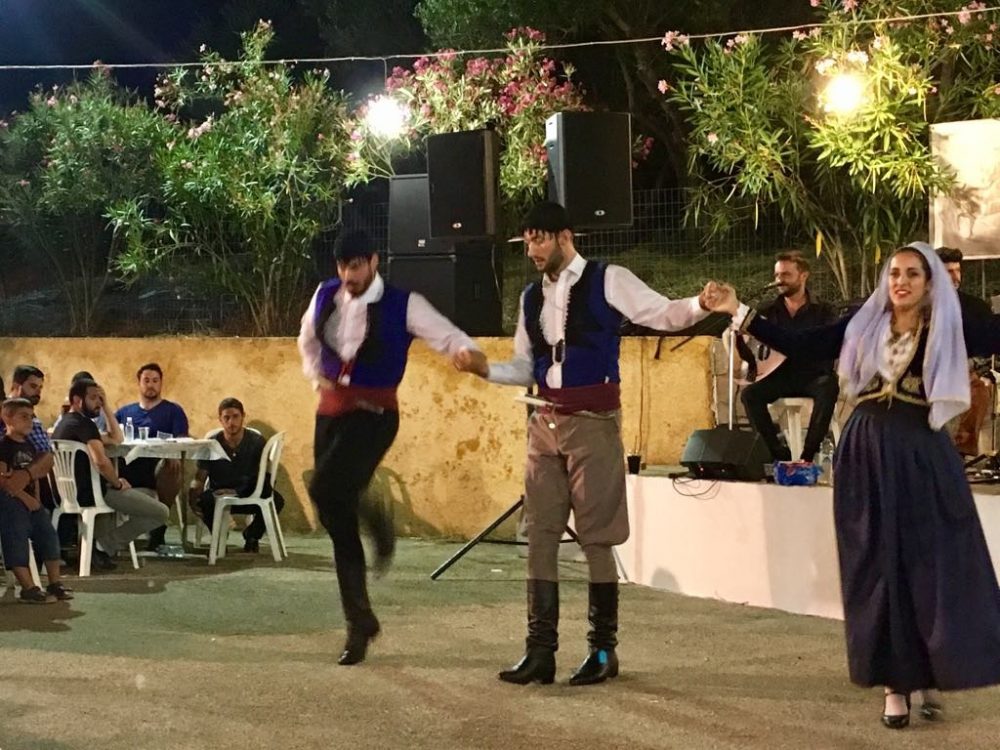
Greece is a lively time to visit during the Assumption of Mary | Image credit Athens Urban Tours
Greece
Mid-summer is already a busy time in Greece. But August is a lively time in the country, due to the feast of the Assumption of Mary, also known as Assumption Day. As one of the major celebrations of the Orthodox Church, it’s a great excuse for Greeks to holiday and follow the non-stop celebrations and parties taking place. Religious festivals and saints’ name days are an important celebration in Greece, whatever your religious beliefs.
During this period, some places are marked as top pilgrimage destination, while great traditional festivals called “Panigiria” also take place. Every city’s church celebrates the Virgin’s icon by adorning it with flowers and holding a formal mass. However, if you find yourself in the main city during this time, do like locals do and organise a few days trip to the countryside to feel this special festive atmosphere.
Crete
If your trip destination is the island of Crete during Assumption Day, don’t miss most famous celebrations of the island in the Monastery of Panagia Chrissoskalitissa. The historical building is located on the southwestern side of the island, near Elafonisi Beach with its majestic green-blue waters, pink sand and exotic atmosphere. Built on the top of a rock, this whitewashed monastery includes one gold step. According to tradition, the colour of this step is only revealed to the sinless. Leave aside your sins and enjoy live Cretan music and plenty of food.
Most villages in Crete celebrate Assumption Day in their own special way. Certain villages organise their own Panigiri, where local musicians who are masters of the lyra and lagouto instruments gather in the village. There they play traditional music, while people dance in the main square, drink local wine and eat food – all offered for free. Don’t be upset if you hear celebratory gunshots!
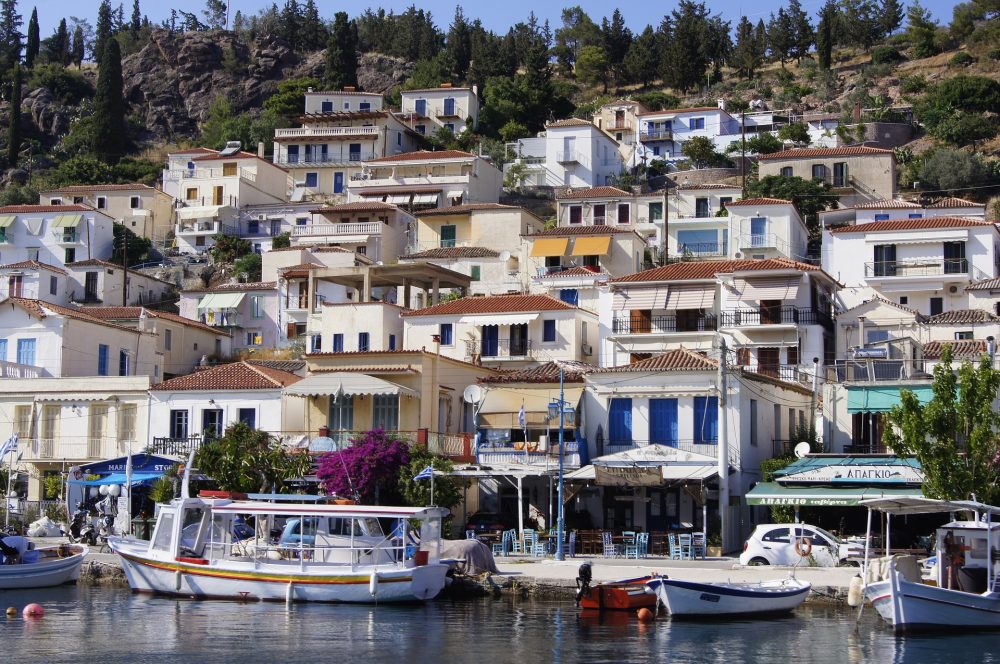
Join in the celebrations on the island of Paros | Image credit Pixabay
Near Athens
If you’re in Athens, catch a ferry and in a couple of hours you’ll be in the islands of Tinos or Paros: two of the most famous places for Assumption Day celebrations in Greece.
The Church of Panagia Evangelistria (Virgin Mary) is the reason why Tinos is linked with religious festivities and a top pilgrimage destination. Every August, thousands of believers flock to the island to pay respects the miraculous image of Virgin Mary. Celebrations start on August 15 and run through to August 23, incorporating the commemoration of the sinking of the warship Elli in 1940 by Italians. While you’re here, don’t miss the local festival cuisine!
The island of Paros is a popular spot to commemorate Assumption Day, as it is home to the Paleochristian Virgin Mary of Ekatontapiliani Church in Parikia, one of the oldest and best preserved Christian churches. After the Epitaph procession of Panagia Ekatontapyliani, created in the 17th century, people start dancing to the local traditional rhythms and enjoying local delicacies and wine. At night, in the nearby port of Naoussa, boats approach the pier with lit torches reenacting the arrival of pirates.
Thessaloniki
If you are in Thessaloniki, follow the annual pilgrimage of Pontians to Panagia Soumela Monastery, located on the slopes of the Vermion Mountains. The church holds the holy image of Panagia, crafted by Evangelist Luke. It was built in 1951 by Greek refugees, in memory of the historical Orthodox Monastery located on Mount Mela, near Trabzon (now part of Turkey). Greek Pontians still preserve their strong traditions, so get ready to experience the procession of the miraculous icon. Dressed in characteristic Pontian costumes, locals listen to traditional songs played by Pontian bands from Macedonia, and engage in mystical Pontian dancing.
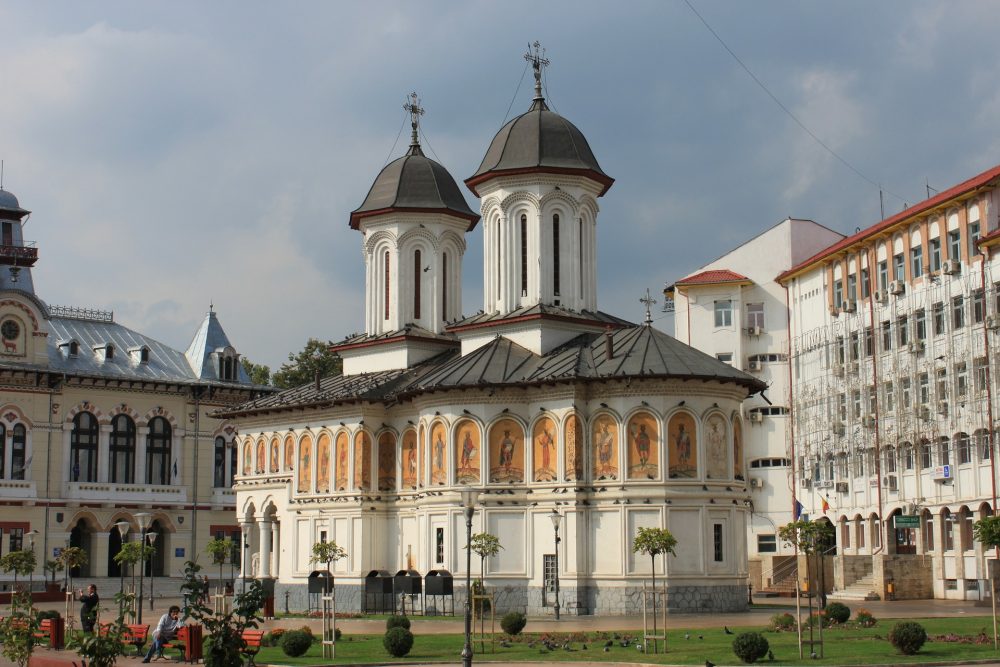
Churches all over Romania welcome pilgrims | Image credit Pixabay
Romania
If you plan a visit to Romania around mid-August, know that August 15 is a national public holiday in honour of Saint Mary’s death. Both Orthodox and Catholic churches pay their respects for the Dormition of the Mother of God on this day. The Assumption of Mary, or simply Assumption Day or St. Mary’s Day, is one of the most important feasts in the Christian calendar. The event honours the belief that when Mary died, her body did not decay but was “assumed” up to heaven and reunited with her soul.
During the day churches and monasteries all over the country, especially with Saint Mary as their holy patron, will honour and welcome pilgrims with a special service dedicated to the Dormition of the Mother of God.
Saint Mary’s Assumption Day is also known as the Feast of Our Lady of the Harvest, the patron saint of the Navy. And so, the date corresponds with the Day of the Romanian Naval Forces. Shows featuring navy ships, helicopters, divers and parachute-jumping are held in Constanta, Romania’s biggest port, and often attract thousands of visitors.
The day also represents the beginning of fall sowing, as well as the start of descent of shepherds coming back from the mountains and the first grape harvest. Take the opportunity to try unfermented wine if you get the chance — one of Romania’s most exquisite flavours.
Where to find Krakow’s best street foodThere’s more to Polish cuisine than pierogies — and in Krakow, there are serious street food stalls, cafes and bars serving up delicious snacks along with a dose of local culture and history. Here’s where to get the best street food in Krakow.
Complex Dolne Młyny
This complex is a real city inside a city, created in the 15,000-square-metre former Tobacco Factory, just a stone’s through from the Main Square of Krakow. All the industrial buildings were carefully renovated to integrate, in a creative way, the local community, start-ups, artists and tourists. Here you’ll find a variety of restaurants, bars, design shops and coworking spaces. Among others, you’ll find a vegan bar, a Mediterranean restaurant, a craft beer pub and a design forum, all so close to each other that you can visit all of them in a night. Incredible, isn’t it? 10 Dolnych Młynów Street.
Zapiekanki od 1980 roku
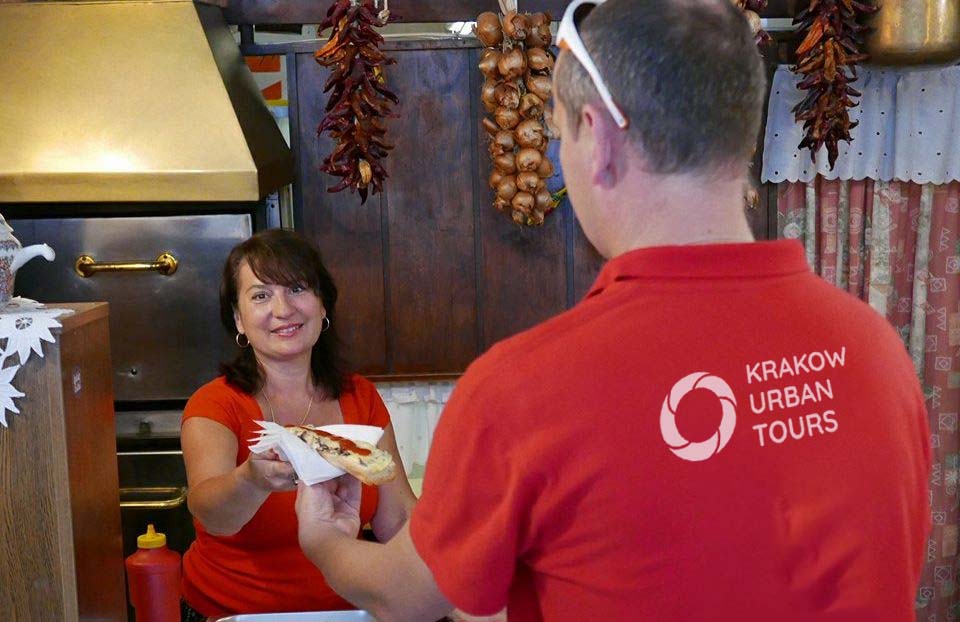
#localsknow where to get the best zapiekanka | Photo by Krakow Urban Tours
In Krakow, you can buy zapiekanka (a long, open-faced sandwich) everywhere, but local residents know there’s only one place where this special taste has survived the turbulent years of transformation. A microscopic shop in the middle of Sienna Street, a stone’s throw from the Main Market Square, Zapiekanki od 1980 roku still maintains tradition and, since 1980, has been selling true zapiekanka.
Ms Marta opened her shop at a time when the cracks in Poland’s Communist regime were starting to crumble; many say her stall was the first fast food restaurant in Krakow — a place where on-the-go meals were sold, flouting the law forbidding American-style cuisine. Her toasted open-faced sandwiches became a symbol of freedom, and eating one was a way of fighting the regime. Today, Marta’s shop doesn’t hold the same political power, but for the locals who remember, her simple sandwich holds heavy, nostalgic significance. 3 Sienna Street.
Hala Targowa
Another option for an unforgettable night in Krakow is to head back to the Kazimierz district, known for its nightlife, and spend the rest of the evening roaming local bars, talking to people and dancing. If you feel hungry at some point, don’t miss the excellent smoked sausages and fresh rolls with mustard, served right on the street directly out of an old blue Communist-era van at the busy market place Hala Targowa, located between Kazimierz and Old Town. 4 Grzegorzecka Street.
Judah Square
This is a great corner of the former Jewish district, Kazimierz, and is where you can find different food trucks and eat local snacks while checking out the huge white and black mural made by artists participating in the Jewish Festival some years ago. Reasonable prices and enthusiastic sellers are two of the biggest highlights of Judah Square. My recommendation is to try kumpir, a huge potato served with cottage cheese, green onion and a long list of other optional ingredients. Other good options are more international, but also very, very tasty: Belgian frites, Czech trdelnik or typical British fish and chips sold directly from ane original double-decker bus. Go inside, it’s well worth it! 16 St. Wawrzynca Street.
Stary Kleparz Farmers’ Market
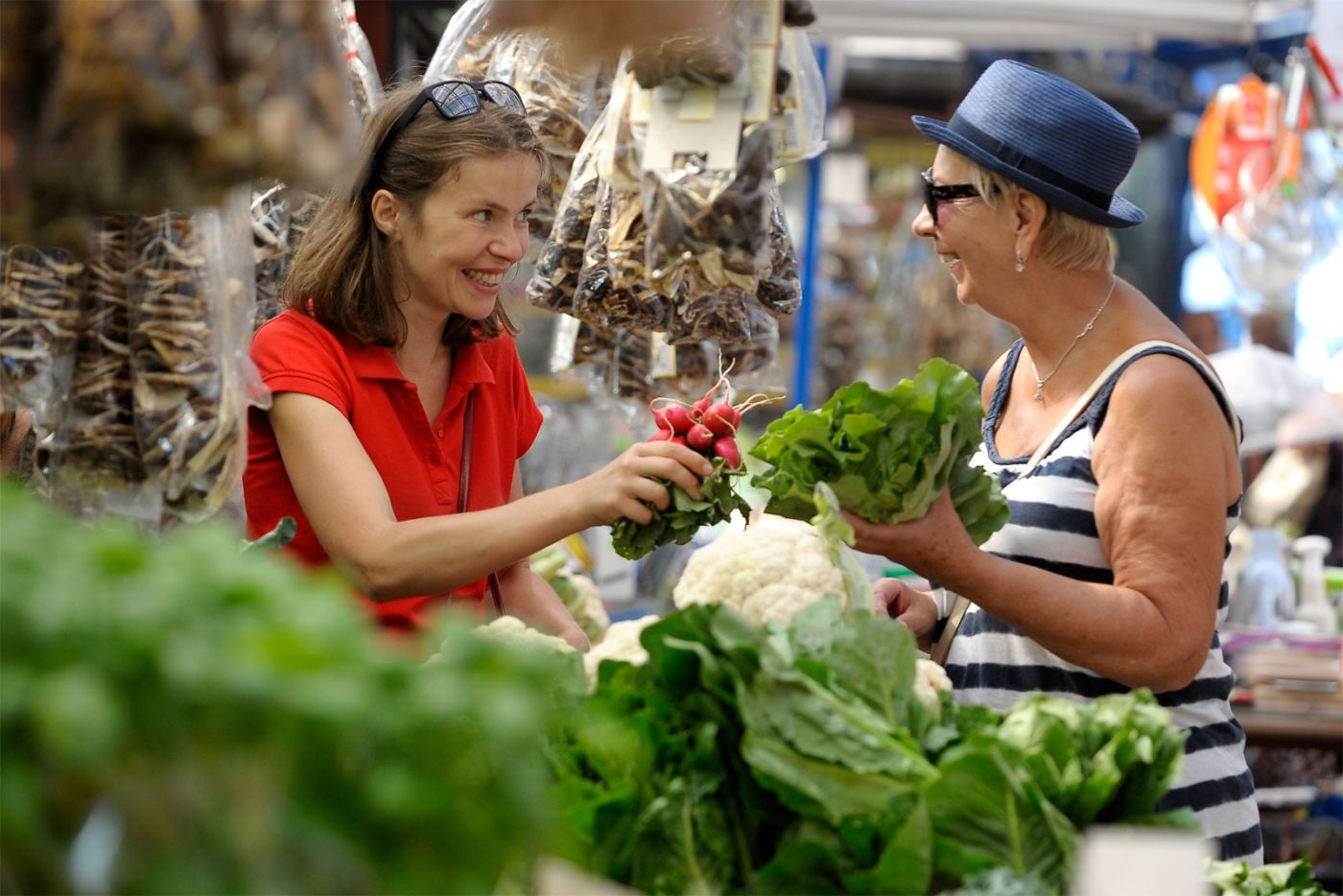
The Stary Kleparz Farmer Market is Krakow’s oldest market | Photo by Krakow Urban Tours
For the best food shopping in Krakow, we recommend Stary Kleparz Market, located very close to the Old Town, just north of St. Florian’s Gate, between Matejko’s Square and Dluga Street. Having run since the 18th century, this is the oldest and most colorful market, where farmers bring fresh fruit and vegetables to sell daily, and for quite reasonable prices, too. You will always find locals here looking for good bargains. Try some samples of fresh mountain cheeses oscypek and bundz, famous Polish sour cucumbers or sauerkraut, and locally made sweets. As there are some expats in the city, Kleparz also offers small shops selling typical Hungarian, Italian and even Arabic foods. Do not miss this place as they have great decor, good prices and fresh coffee that smells like heaven.
Plac Nowy
New Square is the most classic place for locals to hang out. Wherever you look, there is a bar or restaurant, and many locals will spend an entire night in this one spot. You could meet up with friends at one corner of the square and then spend hours visiting the different bars around it. Every Sunday morning there is a huge flea market, where I often go to look for vintage furniture, old records or handmade pottery.
Every country has its stereotypes: Swedes are tall, blonde vikings, the Scottish all wear kilts, Germans have no sense of humour, and every Australian knows how to surf.
Poland is no different. While everyone assumes we drink nothing but vodka, that’s not the full story of our drinking habits — or anything else. Here are 10 things about our country that might just surprise you.
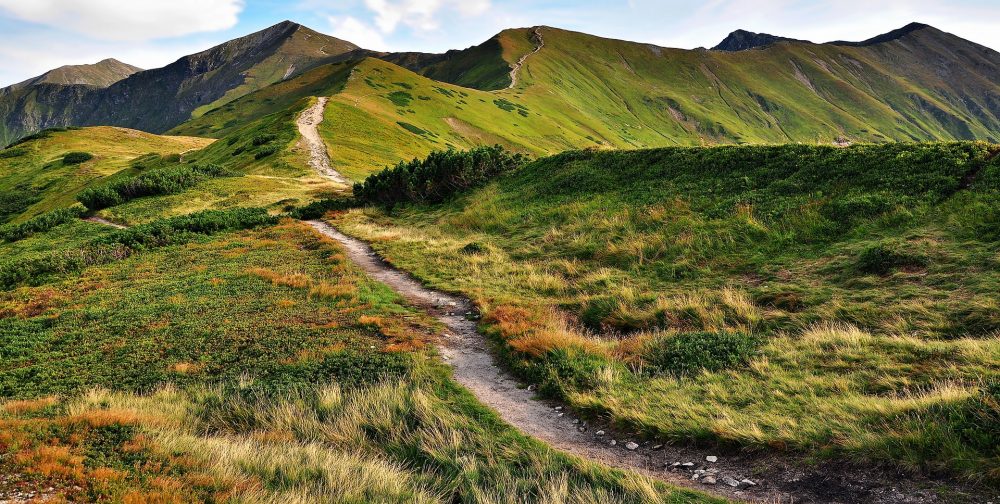
The beauty of Poland | Credit Pixabay
Poland has an incredibly diverse landscape
Poland is a really interesting country in terms of sightseeing. Our landscape changes from the north to the south, like a kaleidoscope showing its great variety and beauty. In the north is the Baltic Sea with sandy beaches and vast forests. Go further south and you’ll find the famous land of a thousand lakes, Masuria, an area with many opportunities for activities in the summer months. The central part of Poland is rather flat, covered with light birch forests and agricultural lands (not counting Warsaw, our capital city). South of the country, where the city of Krakow is situated, is hilly and mountainous.
In addition to our natural attractions, there are many cultural attractions to explore in Poland. We have many interesting cities full of old churches, castles and palaces. There are plenty of charming villages with wooden, hand-decorated houses, still alive with local folklore.
There are many famous Poles who you probably didn’t know were Poles
Visitors to Poland don’t realise that so many famous people and celebrities were born here. On their first visit to Krakow or Warsaw, visitors discover the most famous astronomer, Nicolaus Copernicus, was a Pole. World-class composer Fryderyk Chopin originated from the small village of Zalazowa Wola, close to Warsaw. Other surprises include scientist and Nobel Prize-winner Marie Curie from Sklodowska, and Karol Wojtyla (widely known as Pope John Paul II), born in Wadowice. If you want to impress Poles, surprise them with your knowledge. Believe me, they will be eternally grateful.
Today’s Poland has lost much of its multiculturalism
Today’s Poland is a homogeneous country. Not only is most of the population native Poles, but more than 90% of us, according to statistics, are Roman Catholics. This situation is a sad picture after World War II. Previously, our society was multicultural, multi-religious and multi-ethnic. Nowadays, only in big cities will you meet other foreigners, among whom are tourists, temporary workers or foreign students. The situation is changing slowly, and in my generation there are some intercultural marriages (like mine for example!). Still, it is currently a very small percent of our community. What can be really strange for visitors is that many Chinese, Indian and Arabic restaurants are run by Poles, and mostly local students of the Academy of Music perform famous Klezmer concerts in the Jewish quarter of Krakow.
Our language isn’t as hard to speak as you think
The Polish language is not the easiest to master. On the other hand, at least pronunciation is quite simple and regular. If you know the basic rules, you can be confident of your pronunciation. The only troublemaker is the number of consonants, especially those humming and hissing, often situated close to each other. The distinction between c, cz, s, sz and rz can be confusing. The best way to learn is to try to properly pronounce geographical names like: Suwalszczyzna (beautiful lake district in the northeast part of Poland) or Plac Trzech Krzyży (the big square in Warsaw). For the advanced, try to order scrambled eggs with onion, which in Polish sounds as easy as “jajecznica ze szczypiorkiem.”
We love to ask questions
While on a sightseeing tour in Poland, if you think the person with the microphone at the front of the coach is a bit much because they talk non-stop, just know that for us it’s perfectly normal to listen to so much information. Poles love to visit places and ask questions about those places. A Polish tourist entering a restaurant wouldn’t ask what was on the menu — the questions would be about the history of the restaurant or some interesting fact. Don’t worry, our pwn Krakow tour guides know that sometimes it is more important to eat than to bombard guests with historic details about where you’re dining.
Polish pop culture is often about WWII
Although World War II ended many years ago, it was such a big trauma for our society and it had such a big influence for Poles even today that it remains very much part of our daily life. The war is present in many Polish movies, even modern ones. We have a lot of documentaries and psychological films or dramas connected to the war. What may seem even more weird is that even Polish comedies or soap operas always have at least one episode from the war time, or about heroes from World War II.
READ: How to be a responsible tourist in Krakow
We sleep without blinds and dislike air conditioning
In Poland, the sunlight is something really precious, as during the winter we don’t have it in abundance. Don’t be surprised then, that in many homes there are no blinds or even curtains. The average Pole sleeps with uncovered window and wakes up to natural light. The same works for air conditioning, which doesn’t make us happy at all. The only places which are fully air-conditioned are big offices of international companies, employing mostly foreigners. And, believe me or not, for many Poles, air conditioning in the workplace is such a big obstacle, that they will quit their jobs and look for somewhere with natural light and air.
Expect a small payment to use a public toilet
Don’t be surprised if somebody asks you to pay 1 or 2 zlotys (about 0.25 to 0.50 euro) to use the toilet. Sometimes it happens even in the restaurant where you are dining, or in the popular museum you’re visiting. It is a common thing in Poland and the money serves to support the cleaning service. Be prepared for this and bring some coins, as sometimes you need to pay by machine. For our justification, I can only add that such a payment is not a Polish invention. The idea came from the Roman Empire and was introduced by the emperor Vespasian (ruled AD 69-79), who knew very well that ‘pucunia non olet’ (money does not stink).
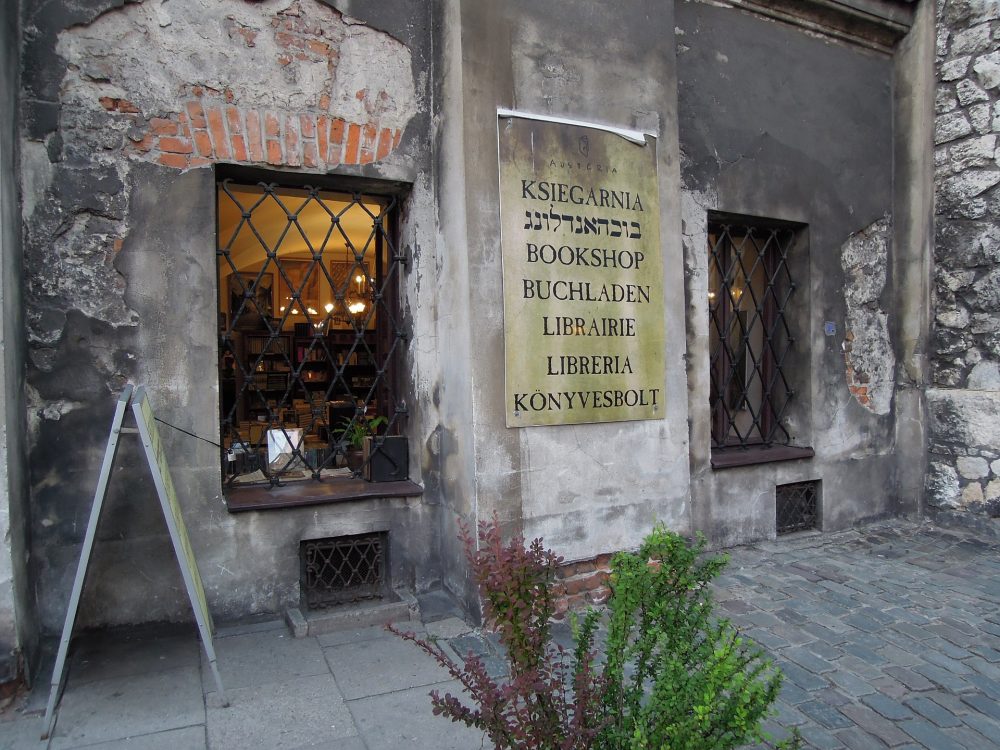
Dining out in Krakow | Credit Pixabay
Restaurants are always open and there are no ‘proper’ hours to eat
Poland doesn’t have siesta and our restaurants are open all day long and always ready to serve anything you want. Of course, in the morning people would rather eat cereal or sandwiches than pierogi. At lunchtime, we more frequently eat soup than apple cake, but if you want to have something different, it’s perfectly okay. We are definitely less strict than Italians or French when it comes to eating habits and the proper order of dishes to be served. Order a pizza and cappuccino together and you’ll probably see a surprised look on your server’s face, but without any doubts, everything would be delivered as ordered. The best hour to observe our different eating habits is noon. Enter any restaurant in the middle of the day, and you’ll see people still eating breakfast, while others are tucking into meat with potatoes, or coffee with cake. We enjoy our liberty when it comes to eating out.
We drink much less vodka than the stereotype
Many people visit Poland thinking that everyone here drinks a lot of vodka, on any occasion. Nothing could be further from the truth. Maybe in the past, during communist times, people drank more homemade vodka, because it was hard to get any other alcohol. Today, most friends meet over a beer, and when the opportunity arises to enjoy an elegant dinner, we drink good wine (yes, yes, there is such a thing as Polish wine, although it is difficult to get, and sometimes a glass of Polish wine is more expensive than the entire meal!). Vodka is usually reserved for the most important toasts, such as toasting the happy couple at a wedding.
The legend of Krakow’s Wawel DragonDo you know the most famous story in all of Krakow? It involves a tale of a poor man who was brave enough to save the Duchy of Krakow with his creative idea and a hint of alchemy. Our story even answers the question of why Poles don’t like to drink water while eating…
Back in the mid 7th century, in the time of the legendary Prince Krak, the prosperous Duchy of Krakow was going through one of its worst moments. Imagine being so afraid to leave your home and shaking every time you hear the screaming roar of a dangerous dragon. This beast, which lives in a cave at the bottom of Wawel Hill, looks to feed every single morning and kidnaps women. The prince knows that none of them ever came back alive. He also knows the city will be completely destroyed if the dragon does not kidnap a new woman every week.
Forced by circumstances, Prince Krak creates a cruel lottery every seven days to elect a new victim. All the citizens wait in their homes, their heart in their mouth, for the announcement from the Prince’s court. Who will be next? Which household will be mourning forever? Desperate to rid the city of the dragon, Prince Krak offered money for killing the beast. But nobody could help, the dragon was always the winner.
Eventually, Krak’s only daughter, the beautiful princess Wanda, was selected. Not only was the prince distraught with the election results, but also the whole Duchy was in despair. This time Prince Krak promised half of his land and hand of his beloved daughter to the brave knight who could kill the dragon and save the Duchy.
Over the next two days, a never-ending procession of armed knights and nobleman came to Wawel Hill to fight with the beast. None of them could kill the dragon. In the early morning of the third day, Krak had to make a painful decision. He announced that enough innocent blood had been shed and the only way forward was to offer the life of his daughter. At dawn, a sad procession marched towards the dragon’s cave. Beautiful Wanda, dressed in a white dress decorated with fresh flowers, was at the front. She was serious, but calm. Nobody could see any signs of fear on her beautiful face. Her father was far from at peace. It was sad to see this powerful man and strong ruler of the country in such a deep despair.
The prince knew that he was about to lose his beloved daughter, but he couldn’t accept it. Each step towards the cave was hard for him and the other citizens who came to say a last goodbye to Wanda. Ten steps, nine – the princess turned her head and looked at the castle for the last time. Eight, seven – she came closer to the Vistula River and took a deep breath, as if she wanted to remember its smell forever. Six steps, five – she turned to the people, hugged her father for the last time and with her hand ordered everyone not to follow her. Still calm, Princess Wanda continued alone towards the cave. Four, three, two more steps towards the end of her life. The people watched the princess entering the dragon’s den. Soon, they heard screams and started crying thinking it is all over.
Believe me or not, but they were wrong.
Instead, Wanda ran out of the cave with a young man. They gathered the others to the river shore to show them pieces of the dragon.
You probably want to know what happened. This shy man, called Dratewka, had a great idea and he saved Wanda’s life before she even saw the dragon. He defeated the dragon not with arms, as he was a poor shoemaker, but with his big heart and open mind. Dratewka had killed a sheep, removed all it’s guts and instead replaced it with sulphur. He sewed up the skin of the sheep and left it as a tasty morsel in front of the dragon’s den.
In the morning, the awful creature saw the sheep and without thinking, ate it rapidly. Sulphur started to burn the dragon’s guts, so he ran as quickly as he could to the banks of the Vistula River to drink water. He drank so much water so quickly, eventually the dragon broke into pieces.
Dratewka was beet red as he explained to the crowd and the prince how he had tricked the dragon. Prince Krak hugged the man, Wanda kissed him twice on each cheek, and the grateful people carried Dratewka all the way back to the castle.
Perhaps you’re thinking Dratweka and Princess Wanda soon got married and lived happily ever after. However, nothing like this happened. Their luck was quickly interrupted by the invasion of German tribes. But, as they say, that’s a story for another day.
Today, a statue dedicated to the Wawel Dragon sits at the foot of Wawel Hill and visitors can visit the dragon’s legendary cave. Listening to this legend from our childhood, we Poles are always afraid of drinking pure water. We know that it can bring bad luck if drunk in big amount.
Discover the dragon and more Polish history on Urban Tours Private Krakow: The Royal Way tour
Ultimate guide to being vegan in KrakowPolish cuisine at first glance is not very vegan, but in Krakow, vegan and vegetarian restaurants have been popping up like trendy mushrooms, there are so many of them now that it’s hard to keep track. This is great news for vegan travellers to Krakow or anyone who wants to eat a more plant-based diet. Want to know more? Our local city guide, Monika, shares everything you need to know about being vegan in Krakow.
Local food
You can’t talk about local food in Krakow without talking about pierogi. While not inherently vegan, pierogi can be made vegan if you omit eggs from the dough (totally possible) and stuff the delicious dumplings with plant-based ingredients rather than cheese or meat.
Something you’re likely to see a lot of in Krakow, is obwarzanki, one of Krakow’s staple street foods. This dough ring (kind of like a bagel) is sprinkled with salt, poppy or sesame seeds and can make for a quick vegan snack. Some are served with cheese, so make sure to avoid those ones.
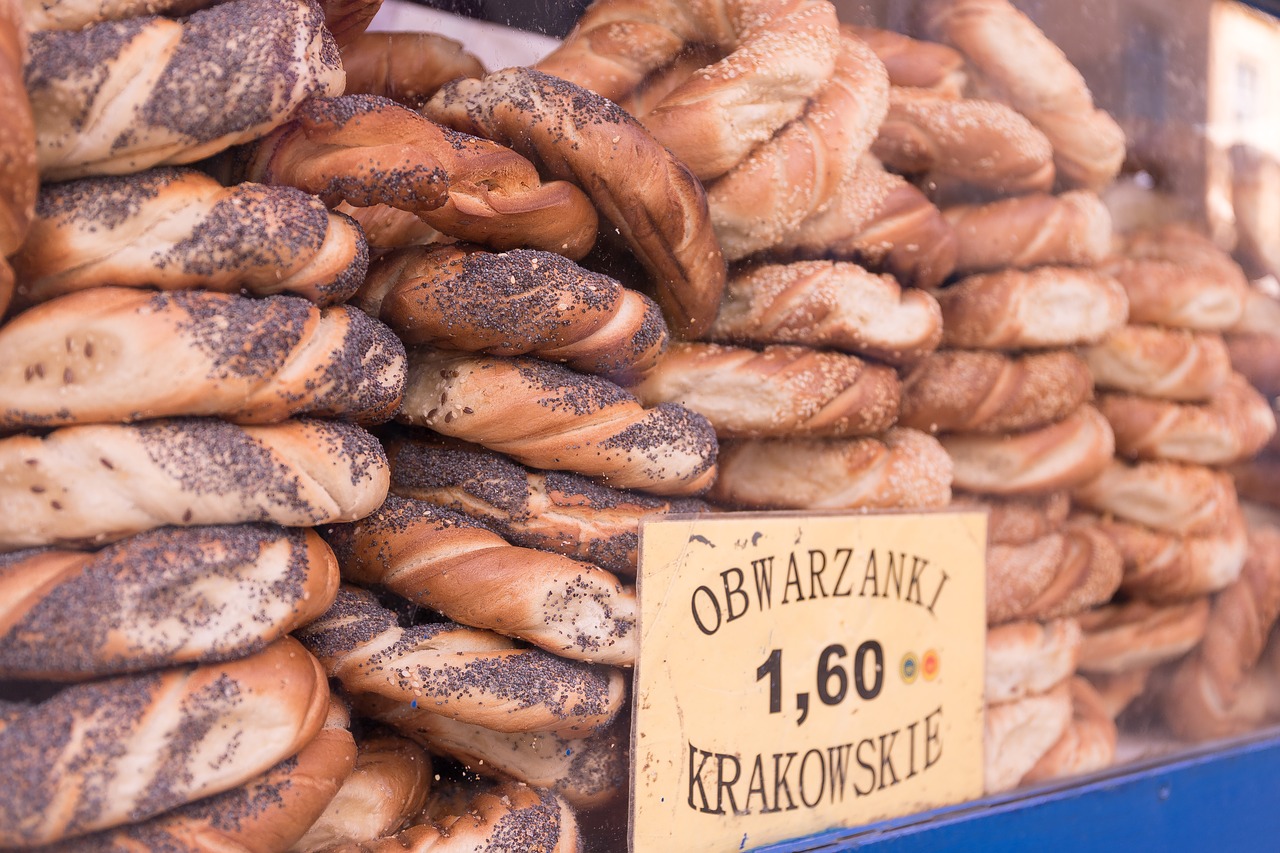
Snack on some obwarzanki, found everywhere in Krakow | Photo via Pixabay
Borscht, a vibrant and hearty beet-based soup may include meat, but it’s just as tasty without, using vegetable stock rather than chicken or beef stock and omitting the meat. Similarly, cabbage rolls, another Polish staple, can easily be made vegan by sticking to rice and vegetables for the filling.
In addition, depending on the season, you can get some seriously good local produce in Poland, something you’ll notice in the sałatkas (salads) you’ll find. Surówka, for example, basically just means shredded, raw vegetables (think slaw) and it can be made with anything from red or green cabbage to celery root and apples. Just make sure those vegetables aren’t dressed in a dairy-based dressing (which is possible).
The Urban Adventures Krakow team offers several vegan-friendly group food tours, like Krakow Food By Foot and Markets & Flavours of Krakow. Just let us know at the time of booking what your dietary preferences are and we’ll do the rest. Alternatively, if you’re looking for a vegan tour that showcases the best of the city’s vegan cuisine, why not let us organise a private vegan food tour just for you. Enquire here for more details.
Eating out
Veganic: Located in the former Dolne Młyny (Lower Mills) cigarette factory complex, Veganic is a fashionable and multi-functional place. Due to long opening hours, the place is good for breakfast as well as for lunch or dinner. I especially recommend the vegan breakfast buffet for PLN 25 (about EUR 7 per person). In summer, a nice garden and live music make the place even better.
Karma: A good place for a quiet lunch, Karma serves a large selection of meatless dishes, sandwiches, and vegetable pates, as well as freshly-roasted, delicious coffee. It tastes like heaven with the local cheesecake or lemon tarte.
Glonojad: This popular restaurant is located in a convenient spot just behind the medieval Florian Gate. It’s worth taking advantage of a two-course set lunch at a good price, which changes every day. I also recommend delicious, freshly squeezed fruit and vegetable juices.
Momo: If you’re looking for a good place for the quick, simple and healthy lunch, Momo is a good bet. The interior is a bit old fashioned, but on the other hand, all the dishes served at Momo are tasty, nutritious, and inexpensive.
Mazaya Falafel: If you love falafel, Mazaya is a great place to full up. In my opinion, they sell the best falafel in the city. In addition, in the summer you will find in a small garden with two small tables and few chairs, which makes for a lovely place to sip your strong, Arabic coffee with cardamom or tea with sweets.
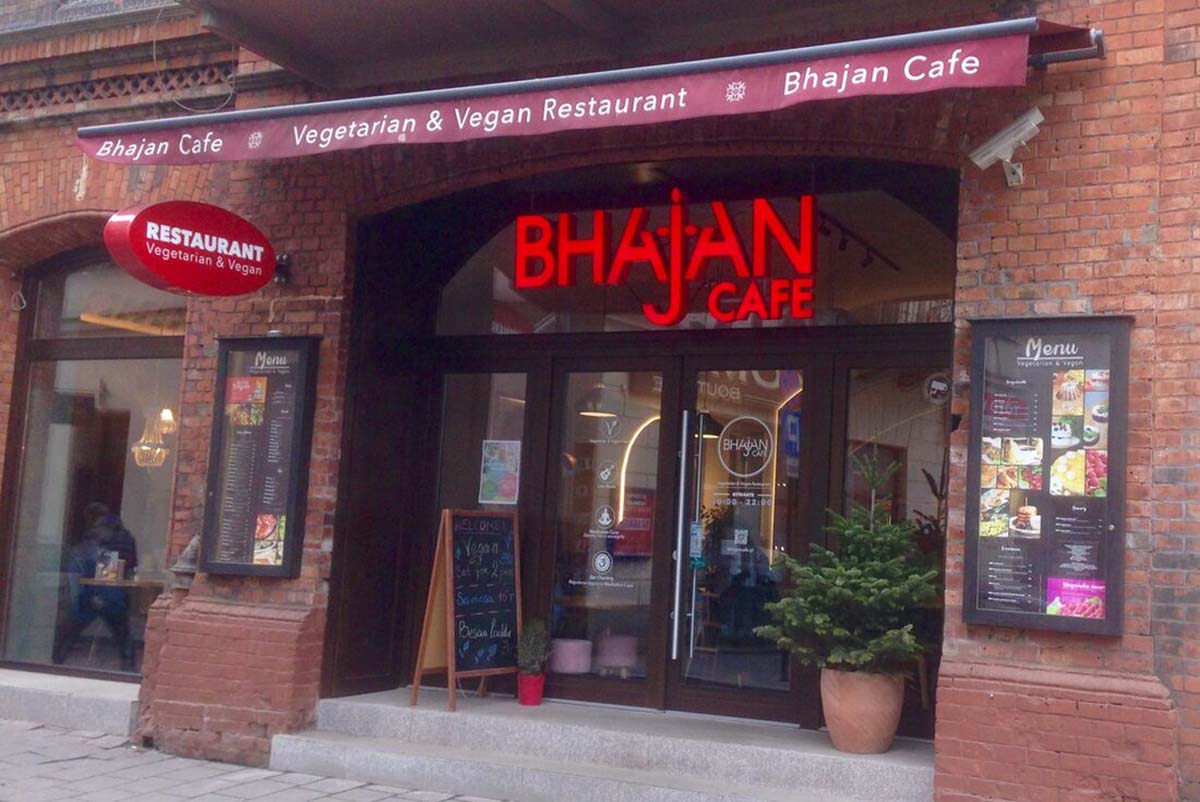
Bhajan serves up vegan and vegetarian Indian cuisine | Photo by Krakow Urban Tours
Bhajan Café: If you’re in the mood for Indian food, Bhajan serves up a menu of vegetarian and vegan Indian dishes with a variety of vegan options to choose from. They also host yoga and meditation events.
Hummus Amamamusi: Sit back, relax, and enjoy the food at this place where you can eat a freshly prepared hummus with pita bread and pickles, drink coffee or squeezed juice, read a newspaper, and even talk with the owners or other hummus-eaters sitting nearby.
Vegab: Fancy a kebab? This spot is the first vegan fast food restaurant in Krakow. Nice interior, good quality products, friendly and enthusiastic owners. A place for everyone, does not matter who they are and what they eat daily.
Shalom Falafel: Krakow’s only kosher street food restaurant, where everything is made exactly like in Israel, and dishes are prepared under the strict supervision of Krakow’s Rabbi Eliezer Gurary. The tiny place hidden in the basement brings to mind Kazimierz of old times. Everything is delicious, affordable and healthy. The only thing that bothers me a lot is the fact that all the meals are served on plastic, single use plates. It would be ideal to come with your own cutlery set and a small plate.
Vegan shopping
Fairma Ethical Design: This spot sells 100 percent vegan, ethical, and fair trade items including clothing, accessories, and shoes for both men and women.
Naturalny Sklepik: Both a café and an organic grocery store, Naturalny Sklepik is where to go for stapes like vegan meats, plant milk and cheese, as well as household products.
KOKOWorld: Head to this local clothing brand to browse and buy unique, handmade clothing and accessories made from natural materials.
How to be a Responsible Tourist is Krakow
Where to Find the Best Ethically-Sourced Souvenirs in Krakow
See all Urban Tours Krakow Group and Private tours
LGBTQ Safety, Nightlife & Sightseeing in Krakow
Safety
Krakow still has a long way to go before you could consider it LGBTQ-friendly. Poland is a formerly communist country that missed out on the sexual revolution of the 60s and 70s; the Catholic Church has been a dominant voice on domestic policy for centuries, hence why same sex marriage is still illegal. Violence towards the LGBTQ community is not uncommon unfortunately, so it’s best to remain discreet and avoid public displays of affection with your other half while you’re in public.
Thankfully things are changing slowly, in recent years the Polish electorate voted in its first gay and transsexual MPs, marking a significant shift in public opinion towards the LGBTQ community. The gay scene in Krakow, Warsaw and Poznan is beginning to emerge from the underground, while May has been declared ‘Queer Month’ and it was estimated that more than ten thousand people attended Krakow’s Gay Pride event in 2019. Things have improved a lot in the past 10 years but there’s still a long journey ahead…
Nightlife
Cocon Club
The Cocon Club was the first and is still the best known LGBTQ+ community club and disco in Krakow located in the vibrant Kazimierz neighborhood at the bank of the Vistula river. There is free karaoke every Friday at 8 p.m. and a disco every Saturday night from 10 p.m. (entrance tickets about 3 EUR)
Lindo Bar
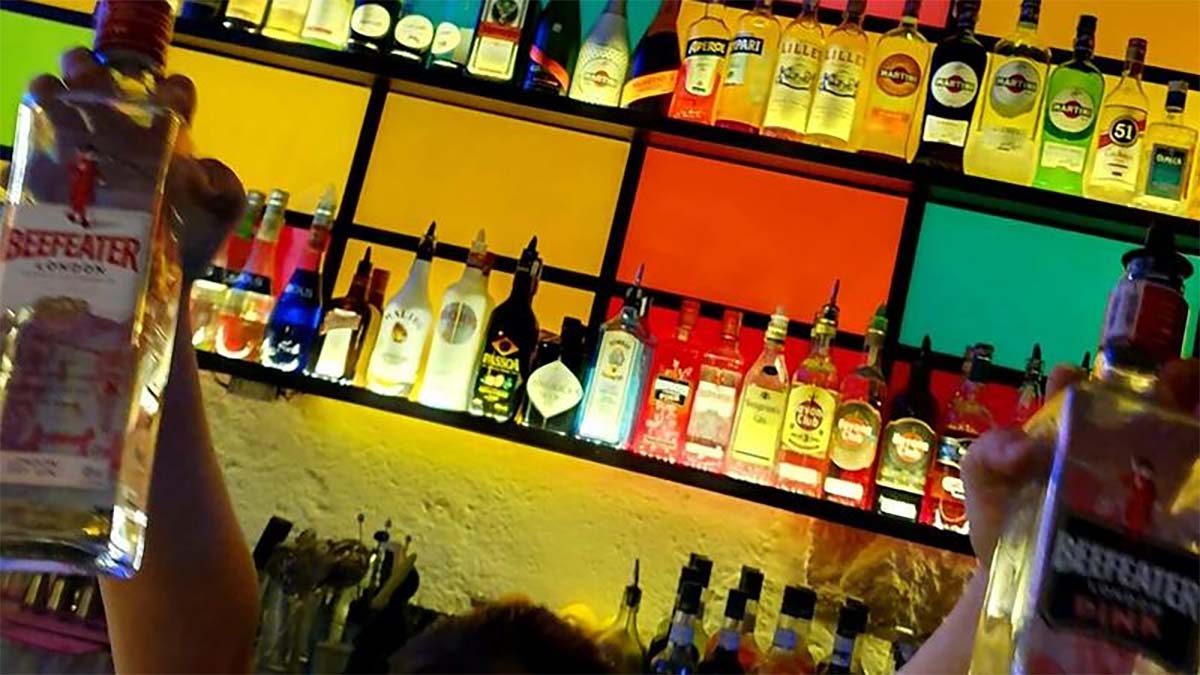
60’s rubik-cube chic at at Lindo Bar on Slawkowska Street. Photo credit: Lindo Bar
Lindo Bar is a fun place in the heart of the city centre, close to Florian’s Gate, to enjoy a beer or a cocktail, dance and listen to music with friends. There’s a friendly vibe that welcomes everybody and prices are cheap.
Club Cabaret
This massive Kazimierz-located club packs plenty of atmosphere, with an interior style reminiscent of the 1920s/30s and a promise to provide “something for the soul and for the body.” Club Cabaret offers a dance hall, bar, restaurant and music space with regular theme nights featuring magicians, burlesque dancers and drag queens. Amateur musicians perform alongside more established acts, creating positive vibes throughout.
LaF
This straight-friendly lesbian femme club is hidden away on Plac Wolnica, close to the river. You’ll need to walk through Cafe Młynek to find the entrance. Drinks are cheap and staff are friendly. There’s a smoking room too, which takes you back to the 1990’s.
Sightseeing & Things to Do
See Krakow’s historic sights and hidden treasures with a local by your side
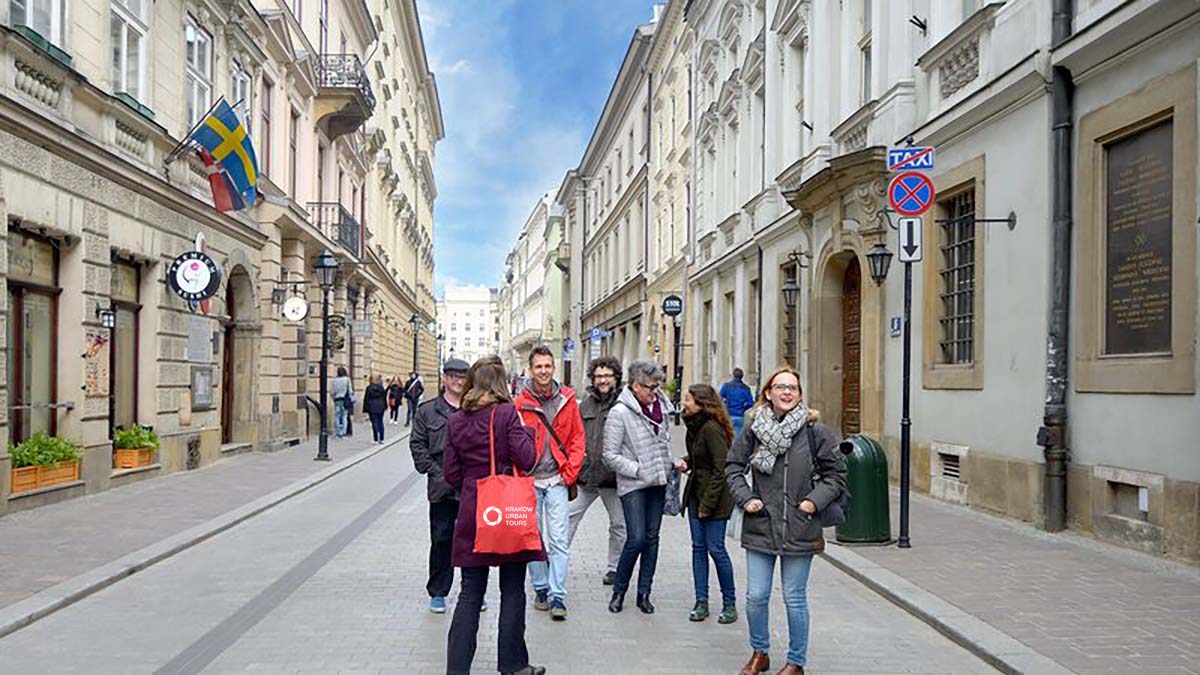
There are A LOT of cultural and historic treasures in Krakow, be efficient and see them with a local guide. Urban Adventures’ Royal Krakow – The Local Way offers intrepid city explorers the chance to ‘walk the royal road’ and admire astonishing fairytale buildings, sample fruit liquors at a hidden bar, and enjoy a meal at a locals’ favourite rooftop restaurant with stunning views across the beautiful old town. If you’re looking for something a little different, check out our
for inspiration. One of our favourite tours is the Made in Krakow Shopping tour where you will discover Polish culture through our handmade products! Together with your local guide, we’ll take you to lesser know neighbourhoods to meet some of the most talented artisans in the city, see the art they’re making for a living, hear the stories behind their crafts, and go home with a piece of Krakow in your pocket!
Eat Sunday brunch at BAL
BAL is a great LGBTQ friendly pub located in an old factory on Slusarska Street in the industrial part of Krakow, very close to the MOCAK Modern Art Museum. They serve delicious breakfast every Sunday and the best coffee in the neighborhood. From time to time they organise film screenings, meetings with interesting people, lectures and many other activities aimed at various communities around the city, including the LGBTQ community, so be sure to check out their Facebook page for upcoming events. They’re open every day between 8 a.m. and 9 p.m.
Show your support Krakow’s first LGBTQ choir
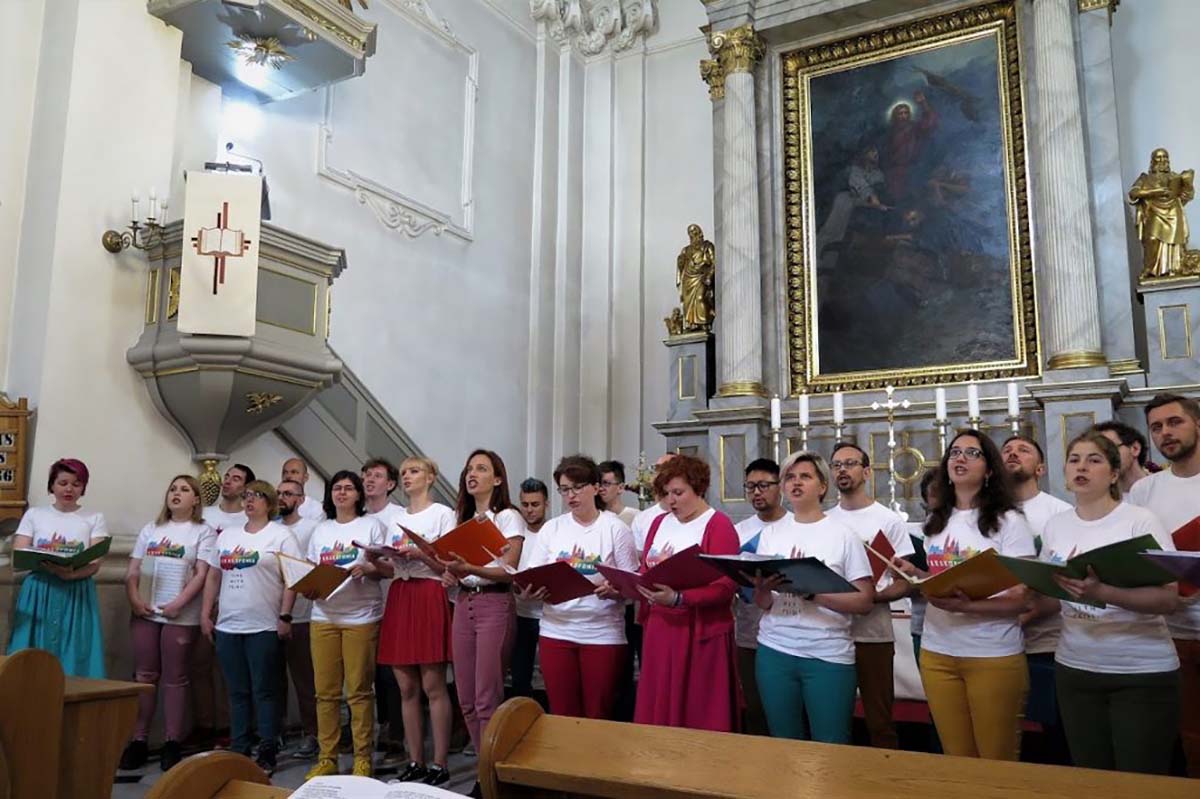
The Krakonia Choir practising at one of their rehearsals. Photo credit: Krakonia
Krakowfonia is Krakow’s first LGBTQ choir (and the second in Poland after Warsaw beat us to it!). The choir is ultra inclusive and is open to everyone. They perform regularly, with rehearsals taking place twice a week.
Browse the books and enjoy a coffee at Ogniwo
A creative space that was conceived by open minded Krakow residents that’s open to everybody, Ogniwo is a friendly joint on Paulinska street made up of a cafe and bookstore and the team here regularly organise lectures, performances, exhibitions and many other activities, aimed at connecting people and showing off their uniqueness.
Admire Polish art
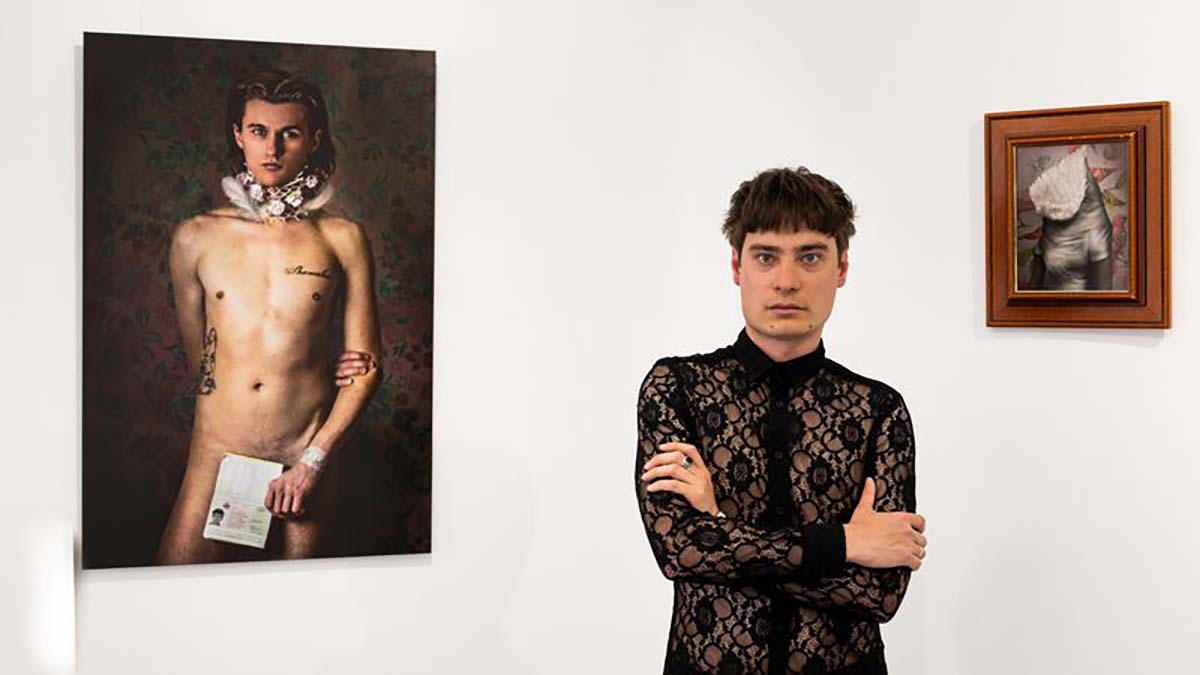
Talented, young Polish artist and scientist – Krzysztof Marchlak currently has an exhibition at the Off Frame Contemporary Gallery called ‘I Will Give You My Heart’ which tackles gender issues. Photo credit: Off Frame Gallery
Talented, young Polish artist and scientist – Krzysztof Marchlak currently has an exhibition at the Off Frame Contemporary Gallery called ‘I Will Give You My Heart’ which tackles gender issues. Photo credit: Off Frame Gallery
Off Frame is an LGBTQ friendly gallery of modern art where you can see temporary exhibitions of creative and independent, Polish artists. We highly recommend a visit to the small Literacka coffee-bookshop, hidden amongst artworks. The Off Frame Gallery recently ran a beautiful photo exhibition designed by talented, young artist, scientist and proud member of the LGBTQ community, Krzysztof Marchlak, called ‘I will give you my heart.’
Visit the LGBTQ Cultural & Community Centre
This brand new community centre in the south of the city opened in June 2019 and will provide support to the LGBTQ community in the form of regular events, mental and physical health services, legal advice and educational resources. Dom EQ have plans to host a regular series of talks on queer literature, as well as film screenings, workshops and exhibitions, so make sure you check out their website to find out what the latest happenings are.
Uncover the stories of LGBTQ prisoners who were held at Auschwitz
The infamous Nazi concentration camp is only one hour by car from Krakow. It’s a grim and sombre experience which isn’t for everyone but it’s so important, may be now more than ever, that we never forget what happened here. Entrance is free but it’s strongly recommended that you go with a guide who can help you make sense of the place. The Krakow Urban Adventures team have organised several private LGBTQ-themed tours of Auschwitz that help to uncover the heartbreaking stories of the prisoners who were forced to wear a pink triangle during their time in the camp. If you would like more information check out this Attitude article. If you’d like to organise a private tour of Auschwitz, please contact the Krakow team.
Krakow Souvenir-making workshop: giving something back to the local communityOur local guide Monika talks about why she is so passionate about her new Krakow tour, which teams up with social enterprise organisation ŻyWa Pracownia (Alive Lab) to support local residents who are living below the poverty line:
My team and I have partnered up with ŻyWa Pracownia (Alive Lab), a socially engaged organisation based in the Podgorze neighborhood of Krakow, that specialises in giving workshops on traditional crafts, design, architecture and urban gardening. The main idea of its creators, Magda and Adam, was to combine nature and folk culture (a natural combination for them as Magda has a background in arts and crafts and is fascinated by Polish ethnographic design, while Adam is a nature lover with highly effective social skills). Together they are dedicated to ecological and cultural education and to the promotion of a world which is open for everybody, without any social or cultural barriers. The organisation is very hands-on in the local community, regularly working on community projects such as designing natural spaces for children, building outdoor installations that enhance neighbourhoods, and introducing urban gardens to built-up areas.
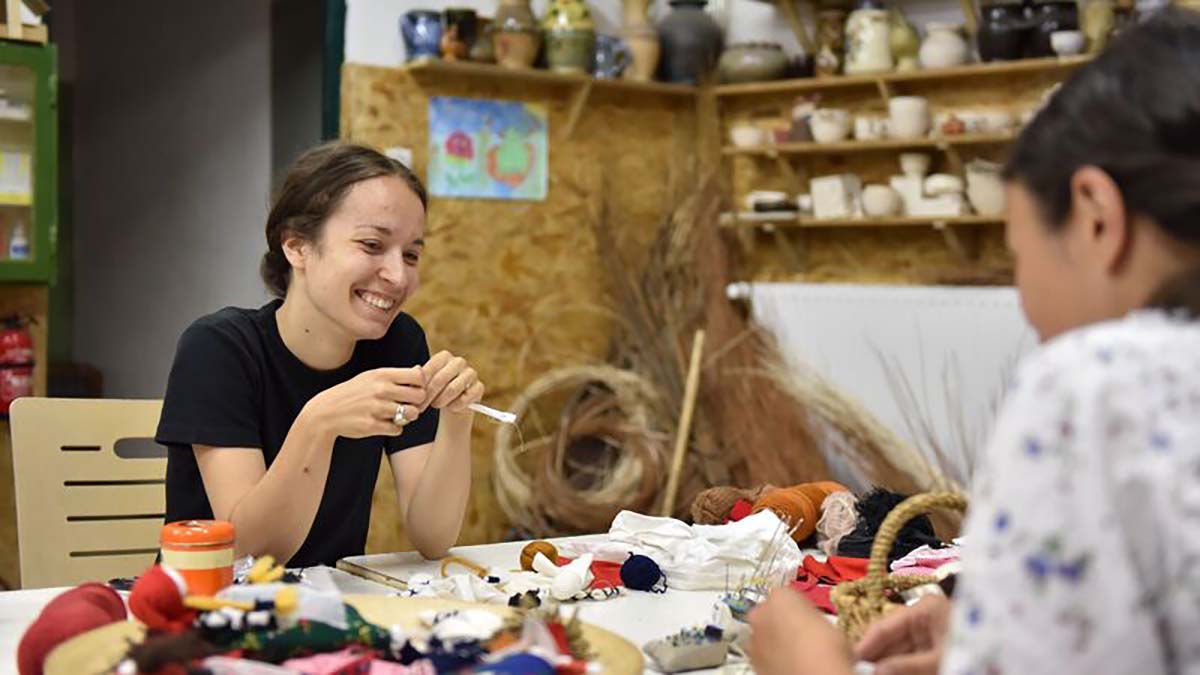
Learning how to make traditional Polish folk dolls with the friendly volunteers at ŻyWa Pracownia. | Photo credit: Krakow Urban Tours
All the workshops run by ŻyWa Pracownia are open for all, particularly those at risk of social exclusion; street children, senior citizens, the poor, the disabled, refugees and the homeless. Many workshops are held at the organisation’s HQ, 5 Celna Street, but they also do a lot of out reach work. ŻyWa Pracownia cooperates with many local non-profit organisations and cultural institutions and are very visible the whole year round as they participate in numerous festivals and cultural events such as the Ethno Festival in Krakow, the Feast for the Poor, the Pannonica Folk Festival in Beskidy mountains etc.
Krakow Urban Adventures’ In Focus Souvenir Making Workshop is your special invitation to see the real city of Krakow, with its joys and sorrows, without separation between locals and foreigners. If you join us on this tour, not only will you learn how to make a traditional Polish folk doll to take home with you, you’ll learn about Polish history and local traditions as well as everyday life in the city and the challenges its citizens face and you’ll contribute directly to the great work of ŻyWa Pracownia.
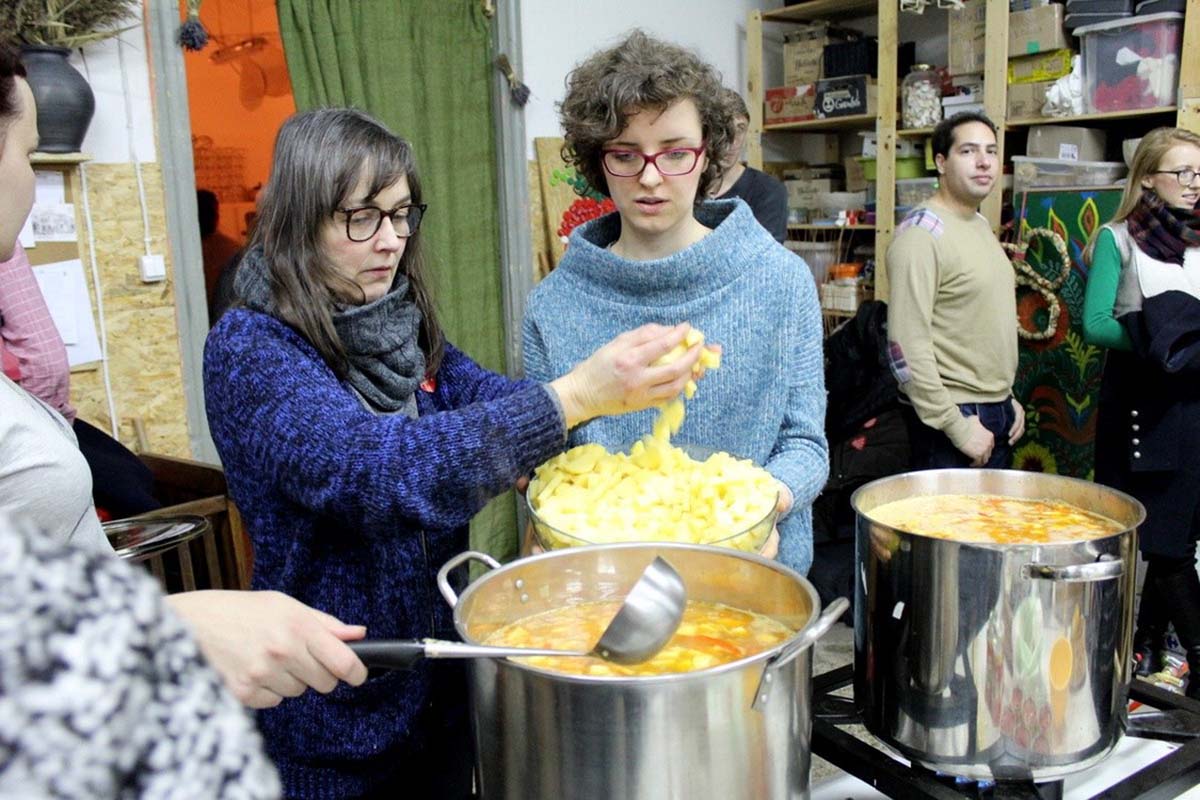
Volunteers helping out at the weekly Sunday Soup Day that takes place in Planty Park, which provides hot food for locals who are below the poverty line and gives them a safe space to come and talk about their problems. | Photo credit: ŻyWa Pracownia
ŻyWa Pracownia are also behind the very special Sunday initiative called – Zupa na Plantach (Soup in the Planty Park), which began somewhat spontaneously some years ago but soon became a weekly tradition that inspires people people all over Poland. Thanks to ŻyWa Pracownia every single Sunday local volunteers work together to prepare a huge pot full of tasty, hot soup; they then bring it from their kitchen to Planty Park near the railway station to share with poverty-stricken local people. Inclusion is a big part of the initiative; eating together shows that the poor are accepted and encouraged to talk about their problems and open up.
In addition to this project, ZyWa Pracownia also provides clothes and hygienic materials for those in need and a Mobile Library for the Homeless which provides easy and free access to education and culture for people who cannot afford to buy books or simply have no home to collect them.
We at Krakow Urban Adventures love what ZyWa Pracownia are doing and we constantly keep our fingers crossed for the success of their mission of helping others. That is why we promote them a lot during our tours and why we participate in the Zupa na Plantach Sundays project regularly. Proceeds from our In Focus Souvenir Making Workshop go directly to support this initiative.
Our tour guests know that the beautiful dolls that they are taking home with them from Krakow as a gift have a story behind them. Each doll made on the tour provides 5 free soups for local people in need. Isn’t it great that you can create something for you and help others at the same time? We really think it is!
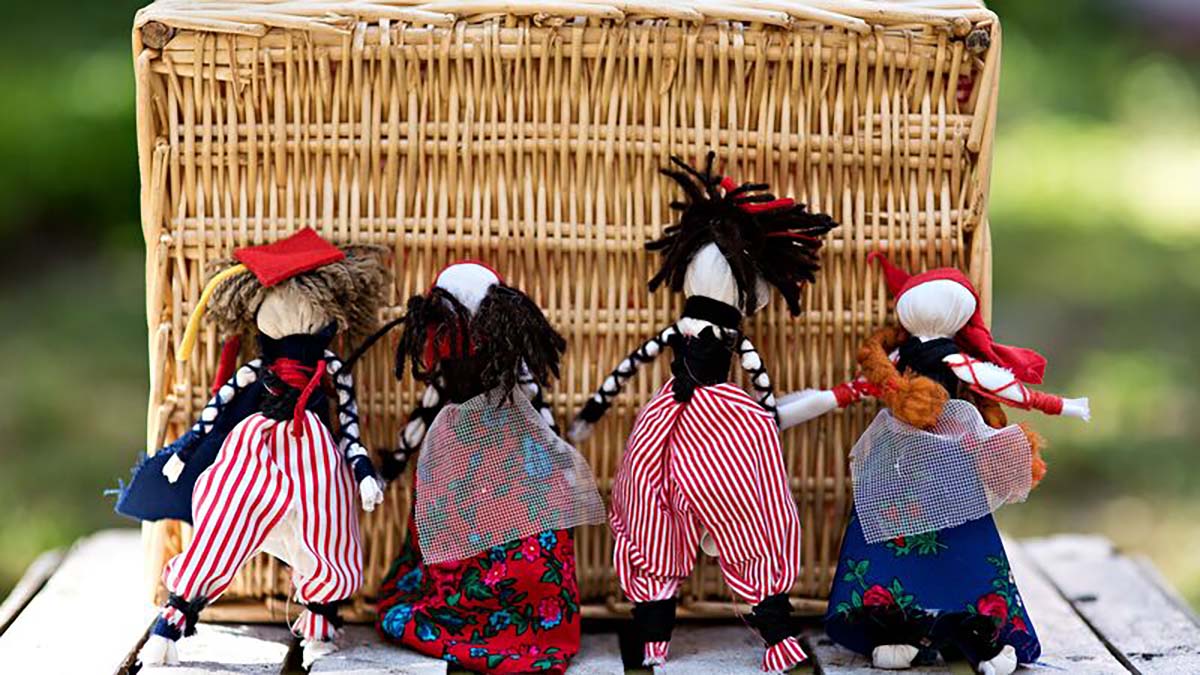
It was the first day of December, the first day of Krakow’s Christmas Market, and, as luck would have it, the coldest day we’d had all week.
I had looked forward to visiting the Krakow Christmas Market for months, but when my alarm went off that morning (and I checked the temperature), that excitement began to fade. I dreaded getting out of bed, but somehow managed to peel myself away from the warmth of the covers anyway.
I piled on multiple layers and asked my boyfriend, “Will the market even be open yet? Surely, no one will be there yet, right?” I wondered why our tour had to have such an early start… but only because I longed for just one (or a few) more hours of sleep.
You see, I’m really not a big fan of winter. I’m similar to a bear in that I would much rather be hibernating… but, alas, I am not a bear… so I sucked it up, ate a quick breakfast, and we headed towards the Main Square to meet up with our tour group.
Our guide Monika greeted us with a smile so warm and a demeanor so welcoming that I almost forgot how cold I was. Almost. Turns out, it was just going to be the three of us.

Monika was cold, too, so we ducked into a little underground café beneath the Town Hall Tower. She briefed us on our tour schedule and offered us a morning mulled wine… because nothing warms the body (or soul) like a boozy beverage at 10 a.m. We did some language learning, too. Cheers in Polish is “Na Zdrowie.” This would come in handy throughout the day.
“I love the holidays,” I thought as I took my first sip. “I love this country,” I thought on the second, and “I think I’m going to love this tour,” on the third. By the last sip, I wasn’t cold anymore, and, just like that, it was time to go out and brave the elements again.
On our way to the Christmas Market, Monika walked us through the Old Town’s Renaissance Cloth Hall. She has lived there for the past 15 years and really knows her stuff about the city. She told us all about the different vendors and their products, what is sold there during the rest of the year, and the history of the Hall itself.
We soon arrived at the Christmas Market, which, despite the early hour and freezing temps, was already buzzing with people. Christmas music filled the air, and the wooden stands were open for business.
Each one sold something different – fun socks, colourful ornaments, wooden toys, furry winter hats… but, my favourites were the stands selling food. It wouldn’t be a Christmas Market without food.

As we made our rounds, the delicious scents of dishes I’d never seen before tempted me almost as much as the barrels (yes, literal massive, wooden barrels) serving up mulled wine. I would have had another cup… but Monika suggested we try something different, because, in Krakow, mulled wine isn’t the only beverage that gives Christmas Market goers those warm, fuzzy feelings. Holiday cheer is also maintained thanks to other hot drinks like vodka… and beer.
After deciding we would give the hot beer a try, Monika took us to another underground bar called Piwnica Pod Baranami or “Cellar Under the Rams.” Once the most famous cabaret in Krakow, it now serves up two popular flavors of hot beer – ginger and raspberry. I was very much unsure how I felt about the whole hot beer thing, but I’m a big fan of ginger, so I went for it anyway. Would you believe me if I told you it was delicious?
Turns out, underground bars, cafes, clubs, and restaurants like Cellar Under Rams are really common around Krakow. We drank our (surprisingly tasty) hot beers, and Monika told us more about Poland’s Christmas traditions.
I found it so interesting learning about how Germany, the Soviet Empire, and other historical influences have impacted the country’s holiday traditions over time. It was even more intriguing Monika’s stories about how she and her family have celebrated. We learned that carp is eaten on Christmas Eve, and that, for a time, the fish was so difficult to find that Monika’s family kept a live carp in their bathtub leading up to the meal… a pet which mysteriously disappeared just before Christmas.
Soon it was time for a pre-Christmas meal of our own… but instead of carp, we had pierogi followed by Poland’s most traditional dish, soup – beetroot soup. We ate our delicious meal in a festive corner of the Green Balloon, another historical restaurant, which was the perfect end to our tour with Monika.
That evening once the sun went down, though our tour had ended hours before, Andrew and I returned to the Main Square. It was our last day in Krakow and we wanted to experience the magic of the Christmas market at night. I now understood why our tour had started so early – It was absolutely packed. We could barely walk through for all the crowds.
We found a spot in front of the stage by the Christmas Tree, and waited with the masses for someone to press a big red button to light it up.
Finally, a man took the stage and invited all the children in the crowd to join him. He called for a count down from ten, which one of the eager kids took this as his cue. He excitedly pressed the button a bit too soon, the tree lit up, and everyone burst into laughter.
The woman beside me turned to me with a smile on her face and said something in Polish. I’m not sure what it was but I laughed, too.
It was the coldest day Krakow had seen all week, and the most magical, too. Turns out, this timeless Polish Christmas Market is worth not hibernating for.
